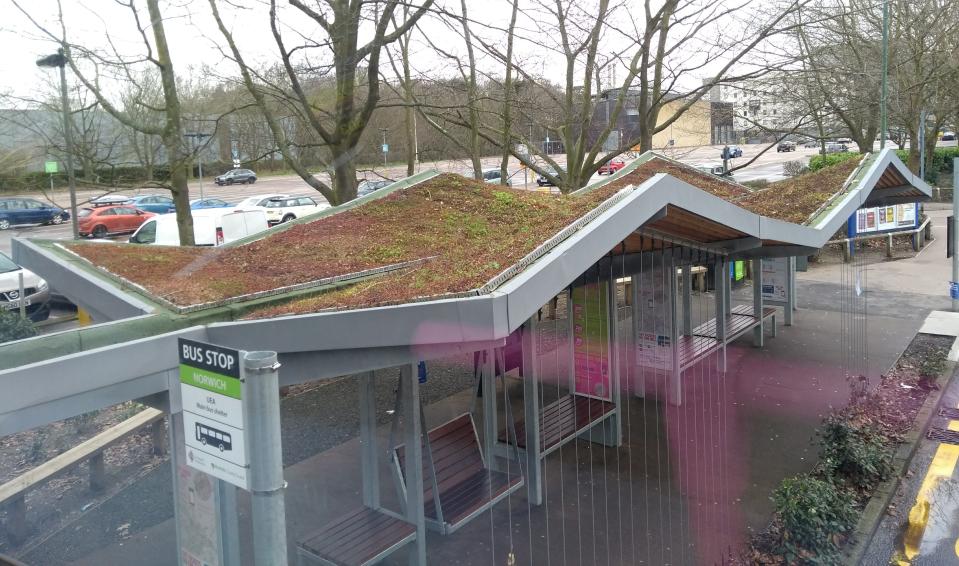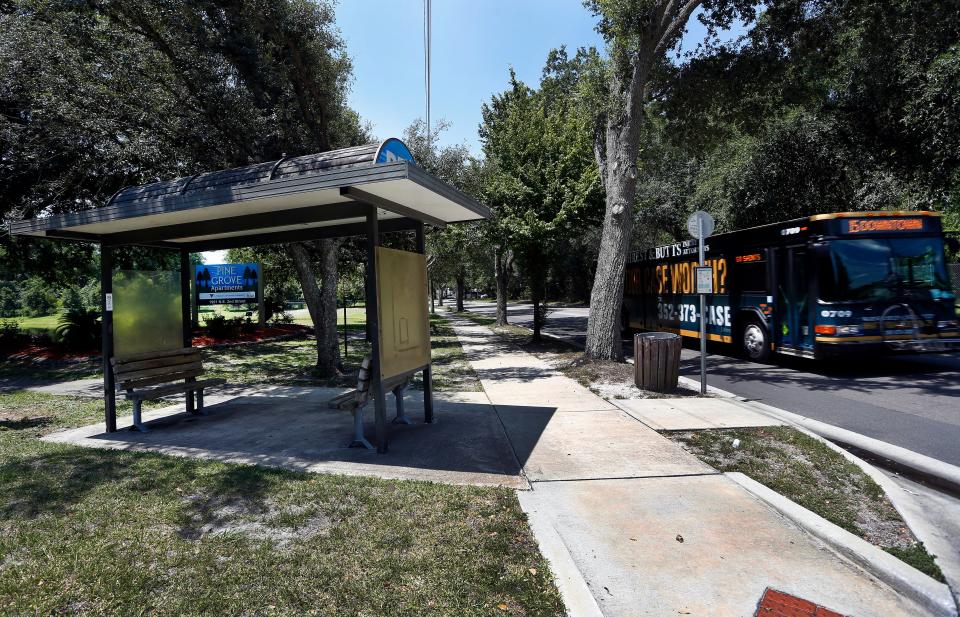Putting green roofs on RTS bus shelters would benefit pollinators, reduce runoff
In Gainesville, issues pertaining to faulty storm drainage systems, urban development and decreasing green space have exacerbated existing environmental problems and prompted the need for innovative solutions. One such solution is the implementation of green roofs on all Regional Transit System (RTS) bus stops in Gainesville.
Green roofs consist of living gardens that include various types of plants and greenery, depending on the environment in which they are placed. They function the same as any other type of roof in the sense that they are durable and protective, but unlike typical metal or shingle roofs, green roofs are extremely beneficial for the environment.
Advantages of green roofs include rainwater storage, the promotion of biodiversity (the variance of all life forms within an ecosystem), energy savings, increases in urban green spaces and reductions in particulate matter or air pollution.

Frustrations regarding the state of development and infrastructure in Gainesville have become increasingly common in recent decades as more and more student housing has been built. As development continues unsustainably and the amount of green space decreases, the city becomes more likely to suffer from the consequences of heat storage in buildings, sidewalks and roads. This is what is commonly referred to as the urban heat island effect and has dangerous implications for heat wave severity and temperature spikes.
Likewise, many Gainesville locals experience difficulties related to flooding and improper stormwater drainage systems. Issues pertaining to unsuitable rainwater storage occur mostly because the overwhelming majority of the city of Gainesville was urbanized prior to the implementation of modern drainage and retention strategies.
In the area of the Hogtown Creek watershed specifically, flooding as a result of unsustainable urbanization and down-stream sedimentation has become a major part of the larger issue regarding stormwater retention. Many areas of the University of Florida’s campus drain directly into Hogtown Creek and contribute significantly to a rise in the floodplain and water pollution.
To address these problems, we must be proactive in implementing innovative solutions such as RTS green roof bus shelters, which have the potential to make a positive impact.
My inspiration for the green roof bus shelters came last month during a stop on my study abroad program in Paris, France. In Paris, green roof bus stops are somewhat common, and in researching them I learned that they were established as part of a collaboration between the city government and the French multinational corporation JCDecaux to meet sustainable development goals in public transportation and increase green space.
Paris green roof bus shelters have fully funded themselves through business advertisements, and this has enabled the city to install additional green roofs in several different areas at no additional cost to them. A similar strategy could be implemented in Gainesville through the sale of advertisements to be posted inside of the RTS bus shelters, something that is not currently an option. Using the Paris model for funding would mean that the RTS green roof bus shelters would theoretically pay for themselves and require little to no further funding.
In Florida, many barriers to installing green roofs on homes and other structures, aside from funding, have been set due to high vulnerability to hurricanes in several regions, a factor that makes green roofs nonviable. The city of Gainesville, however, is uniquely positioned to plant itself as a leader of green roof implementation in Florida because it experiences minimal hurricane risk relative to other areas of the state. Gainesville also stands to benefit the most from green roofs, as they have the potential to reduce stormwater volume by 50-85%.
In Gainesville, the green roof bus shelters might be composed of several types of sedums, a highly resistant plant species common in green roofs, and a few carefully selected native plant species that are ideal for supporting pollinators such as honeybees. Facilitating the growth and reach of pollinator populations is incredibly important because they nurture high levels of biodiversity within an ecosystem through the fertilization of plants and crops.

In Florida, the effects of climate change have been detrimental to biodiversity in many areas due to increased species extinction rates, the introduction of nonnative species as a result of forced migration and habitat destruction. Installing green roofs on bus shelters that include intentional selections of native plant species will promote much-needed growth in pollinator activity and population levels and, in turn, biodiversity.
Aside from the initial installation, which must be completed by professionals, the green roof bus shelters only require maintenance twice a year, something that can most easily be tackled by volunteers from UF and the broader Gainesville community. By engaging the entire community in the installation of the green roofs, a genuine appreciation and care for the aesthetic value of the green roofs will be established, therefore ensuring their continued growth and sustenance in the long term.
RTS has long sought to increase its contributions to sustainability through both its partnership with UF and its own independent efforts. Installing green roofs on RTS bus shelters presents a unique opportunity for the local community, the city government, and UF officials and students to collaborate on an extremely cost-effective solution that serves the environment and all Gainesville residents in positive ways.
In the end, we are all “busy bees,” but by installing green roofs on RTS bus shelters as a collective effort to advance sustainable development, we may find that sometimes, the proper solution is right above our heads.
Erika Steinbruck is an incoming junior at the University of Florida, majoring in environmental science and political science.
Join the conversation
Share your opinion by sending a letter to the editor (up to 200 words) to letters@gainesville.com. Letters must include the writer's full name and city of residence. Additional guidelines for submitting letters and longer guest columns can be found at bit.ly/sunopinionguidelines.
Journalism matters. Your support matters.
Get a digital subscription to the Gainesville Sun. Includes must-see content on Gainesville.com and Gatorsports.com, breaking news and updates on all your devices, and access to the eEdition. Visit www.gainesville.com/subscribenow to sign up.
This article originally appeared on The Gainesville Sun: Erika Steinbruck: Gainesville's RTS should install green bus shelters

